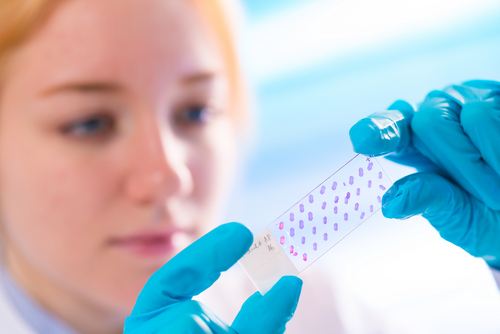Triple-negative breast cancer (TNBC) cells can become resistant to chemotherapy by temporarily turning on molecular pathways that protect the tumor, new research using mouse models and patient tumor samples uncovered.
Since one of these pathways is a metabolic process possible to target, the study may offer new ways of treating resistant TNBC.
The study, “Resistance to neoadjuvant chemotherapy in triple-negative breast cancer mediated by a reversible drug-tolerant state,” was published in the journal Science Translational Medicine.
Current standard treatment for TNBC is frontline chemotherapy followed by surgery to remove the tumor, an approach that is highly effective in about half of all patients.
“However, the remaining half of women will not fully respond to neoadjuvant [pre-surgery] chemotherapy, and there currently,” leaving them with no other specific treatment options, Helen Piwnica-Worms, PhD, a professor at The University of Texas MD Anderson Cancer Center and the study’s senior author, said in a center press release.
“Understanding how tumor cells become resistant will allow us to identify new targets to better treat resistant disease,” she added.
The researchers created mouse models, referred to as patient-derived xenografts (PDXs), which made use of TNBC samples from patients enrolled in the ARTEMIS clinical trial (NCT02276443) that MD Anderson is leading.
Tumor biopsy samples taken before and after neoadjuvant chemotherapy were grafted into mice, allowing the scientists to track the molecular changes occurring in tumors from that point on to better understand the mechanisms behind resistance.
Genomic sequencing revealed that tumors resisting treatment to standard chemotherapies — doxorubicin plus cyclophosphamide — had changed many of their molecular pathways.
Resistant tumors had changed their transcriptomes and proteomes — their RNA and protein makeup that works as a blueprint of the genes and cell pathways turned “on” or “off” — together with their tissue organization.
If treatment was paused, residual (or remaining) tumors resumed growth and were again sensitive to chemotherapy, suggesting that resistance was temporary.
In fact, cell-tracking techniques showed that the variety of cells in a given tumor, known as clonal diversity, was maintained after chemotherapy, suggesting the treatment did not cause a small group of resistant cells to populate residual tumors.
Characterization of gene activity changes showed which pathways were temporarily activated as part of the resistance mechanism.
Many of the molecular changes found in the mouse models were confirmed in samples from ARTEMIS patients.
The pathway most turned on by resistant cells was a metabolic process involved in energy production called oxidative phosphorylation, providing a potential target to tackle resistance.
MD Anderson’s researchers have developed a small-molecule inhibitor of this process, IACS-10759, currently in Phase 1 safety study (NCT03291938) in patients with certain blood cancers and solid tumors, including breast cancer.
In different patient-derived mouse models, treatment with IACS-10759 after chemotherapy delayed regrowth of residual tumors and prolonged treatment response.
This data suggest that chemotherapy followed by IACS-010759 “could prolong TNBC responses in the neoadjuvant setting and delay time to disease recurrence,” the researchers wrote, although such an approach would need to be carefully managed for possible toxicity.
“Our study provides a compelling rationale for defining additional properties that enable triple negative breast cancers to survive chemotherapy treatment, so that combination therapies can be developed to eradicate this disease,” Piwnica-Worms said.
She added that a long-term research goal “is to avoid the use of chemotherapy in patients with resistant disease and instead employ targeted therapies to avoid unnecessary treatments and harsh side effects.”
Future research should also concentrate on whether metastases — tumors that have spread from to other regions in the body — adopt a drug-tolerant state during chemotherapy, as this could affect treatment decisions.

